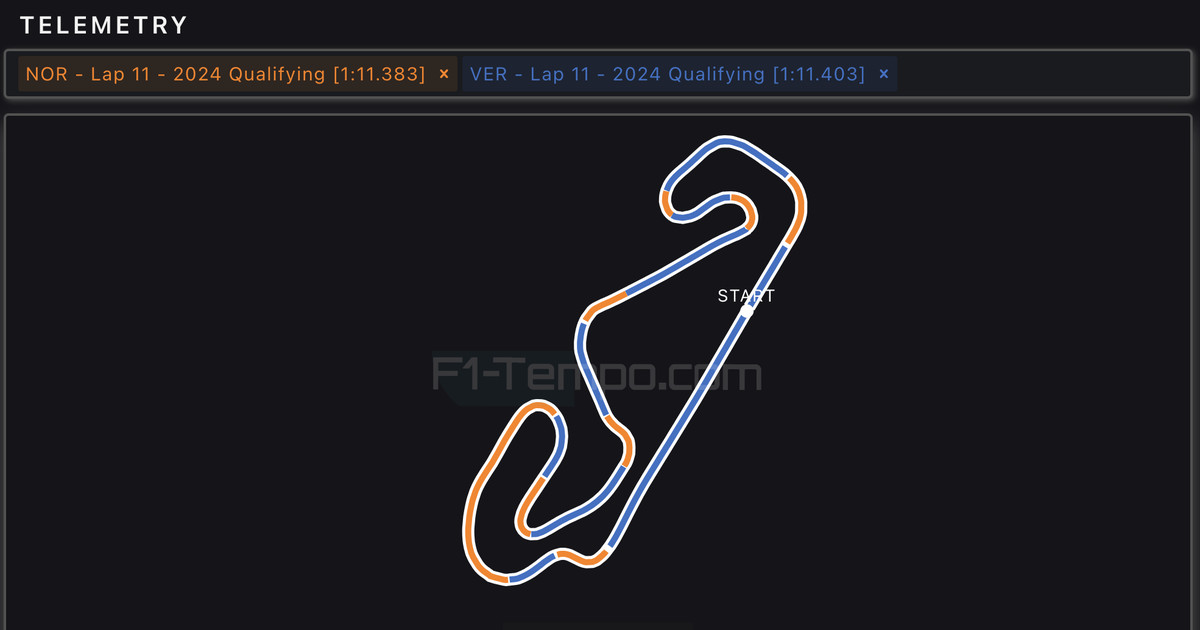Saturday’s qualifying session at the Formula 1 Spanish Grand Prix delivered one of the more thrilling hours in recent memory. A back-and-forth fight for pole position saw Max Verstappen put his RB20 on provisional pole in the closing seconds of Q3, but Lando Norris snatched P1 from his friend at the death, capturing pole position by just two-hundredths of a second.
How did Norris pull off the win, and what might Saturday’s results tell us about Sunday?
Let’s dive into the data a bit, thanks to our friends at F1-Tempo. First we can look at the “track dominance” map, highlighting where each car was faster on their final laps in Q3. As you might expect given recent history, the RB20 was faster on the straights — particularly the long straight coming out of Turn 14 and back to the start/finish line — while the MCL38 was quicker through some of the corners:
As you can see Norris — highlighted in the orange — was quicker particularly in Sector 1, which includes the initial chicane coming out of the long straight as well as the sweeping corner coming out of Turn 3 and heading into Repsol at Turn 4.
But on the straighter portions of the track, and the long straight itself, Verstappen was faster.
Verstappen also posted the highest speed on that long straight, a mark of 329 kilometers per hour. As you can see in this next image, that came near the end of the straight, heading into Turn 1. By comparison, Norris was 5 kph slower at that point:
:no_upscale()/cdn.vox-cdn.com/uploads/chorus_asset/file/25501777/Screenshot_2024_06_22_at_12.31.58_PM.png)
Looking at the delta between the two cars at that point, Verstappen had an edge on the lap of 0.054 seconds per Norris at that point, coming out of that long straight:
:no_upscale()/cdn.vox-cdn.com/uploads/chorus_asset/file/25501778/Screenshot_2024_06_22_at_12.33.28_PM.png)
Then as the cars hit Turn 1, Verstappen’s advantage was up to 0.125 seconds:
:no_upscale()/cdn.vox-cdn.com/uploads/chorus_asset/file/25501786/Screenshot_2024_06_22_at_12.37.41_PM.png)
But as you can see from that above graph, Norris then built a lead as Sector 1 came to a close and Sector 2 began, and he held that lead throughout the rest of the lap, fending off a late challenge from Verstappen coming out of Turn 14 and back to the start/finish line (more on that in a second).
Norris built that lead through Turns 3, 4, and 5. As you can see from the initial “track dominance” map, Norris was quicker from Turn 3 into Turn 4, and while Verstappen had an edge from Turn 4 into Turn 5, Norris built a lead he would not give back. In fact, by the time both cars came out of Turn 5 Norris had gone from being 0.125 seconds down at one point, to being up 0.167 seconds on his friend and rival:
:no_upscale()/cdn.vox-cdn.com/uploads/chorus_asset/file/25501788/Screenshot_2024_06_22_at_12.39.26_PM.png)
And if you look at the entire delta graph, while Verstappen was able to. close that gap over the rest of the lap, he could not make up the difference.
However, there is something to note regarding the final turn, Turn 14, as alluded to above. Take a look at the throttle data for that final turn:
:no_upscale()/cdn.vox-cdn.com/uploads/chorus_asset/file/25501792/Screenshot_2024_06_22_at_12.41.21_PM.png)
:no_upscale()/cdn.vox-cdn.com/uploads/chorus_asset/file/25501793/Screenshot_2024_06_22_at_12.41.30_PM.png)
As you can see, while Norris lifted just a bit heading into Turn 14, Verstappen was able to keep the hammer down through the final turn, giving him a huge run of momentum into the long straight and back to the start/finish line.
That has led to some believing that Verstappen is primed for an even bigger Sunday:
Turn 14 reveals Ferrari’s weakness (which is RedBull’s strength)
Ferrari has less downforce than the othersLEC lifted significantly (72% throttle, 267km/h)
HAM and NOR only needed a tiny lift… but VER remained full throttle! His superior downforce reveals a race-focused… pic.twitter.com/dKOF08O8AZ
— Formula Data Analysis (@FDataAnalysis) June 22, 2024
Could Turn 14 be the difference tomorrow?
We will know soon enough.
